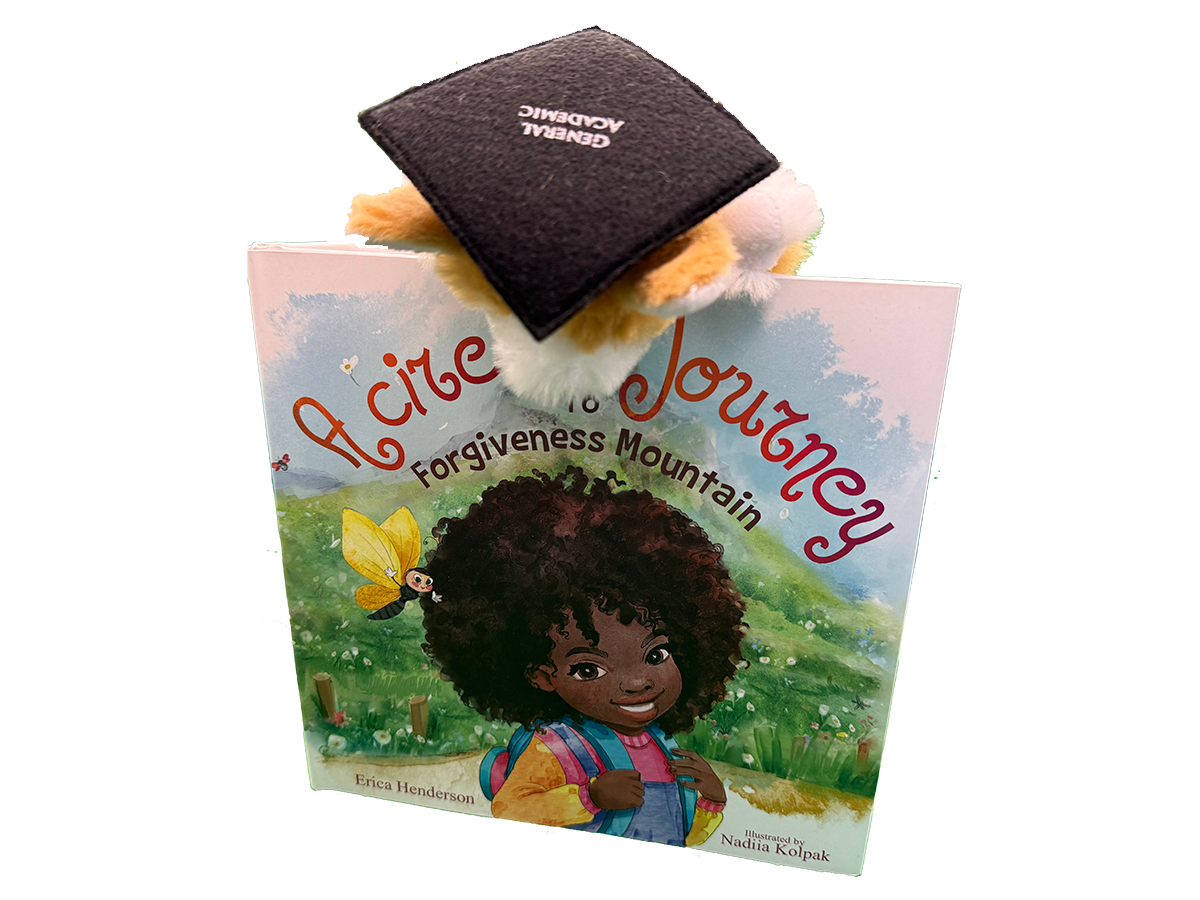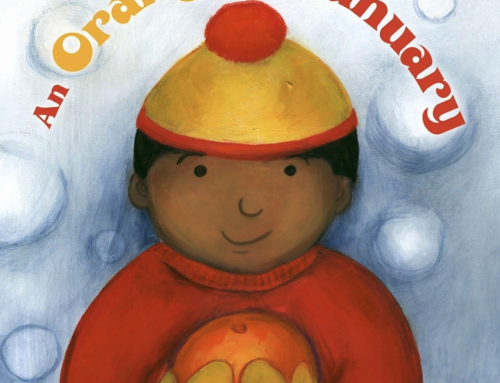
Erica Henderson, Houston Children’s Book Author
As part of our efforts to include local, Houstonian authors in our reading curriculum, we’re proud to feature Erica Henderson who recently published Acire’s Journey to Forgiveness Mountain! Henderson wrote her illustrated children’s book for ages 4-9. We’re honored that she took some time to tell us about herself, her writing process, and her thoughts about the importance of childhood reading.
General Academic already publishes a comprehensive curriculum for English Language Arts (ELA) grades 5-11. We are now in the process of expanding that curriculum down to grades 1-4 particularly for use with our Elementary Learning Program. As such, we’re researching children’s books and are particularly interested in including local Houstonians in our curriculum.
We’ve adapted 9 pages from Acire’s Journey to Forgiveness Mountain and included reading comprehension questions below.
About Acire’s Journey to Forgiveness Mountain
Throughout the book, we follow seven-year-old Acire’s emotional growth after a particularly upsetting day at school: she overhears hurtful words from a close friend. She ends up rushing home, packing her toys, and going on a walk in her neighborhood, where her butterfly friend Omni leads her to an unfamiliar mountain. Scaling up the mountain turns out to be an arduous and frustrating task, but Omni provides gentle guidance, teaching invaluable lessons about emotions and healthy ways to address them.
Acire’s Journey is equal parts educational and imaginative, with the allegorical voyage serving as an easy and entertaining way for the reader to learn about identifying, explaining, and addressing their feelings.
Henderson recommends Acire’s Journey for young children, approximately ages 4-9 years (or novice to decoding readers). A younger reader may need to read aloud with a parent or teacher, while a reader on the older side of this spectrum should have enough fluency to read and process the meaning of the book independently. The Lexile level of Acire’s Journey is estimated to be 610L-800L, which would make it an appropriate read for second or third graders. The Flesch-Kincaid Grade Level from our excerpt is second grade.
Henderson’s Thoughts on The Significance of Reading
Henderson stresses that it is vitally important to read for pleasure, beyond the sake of just reading for school assignments: “reading [is] an imaginative rewriting to real life. It’s another opportunity to get lost in wonderment and escape the stresses of this world. It is video games through printed words, TV shows drawn in our minds. It encourages and inspires our own creativity. The more we dive into books – all types – the more we learn about ourselves and just how intense our individuality is. Reading educates us. It humors us. It concerns us. It builds us up – our vocabulary, our independence, our confidence, and our peace. Our world requires us to have an internal peace, and books that challenge and comfort us are the perfect antidote.”
Henderson’s Advice to Aspiring Authors
It’s never too early for your child to hone their creative writing skills (with Henderson being an excellent example)! She shared a couple of tips with us, all of which your student can begin incorporating as soon as today:
- Write down everything.
- Seek mentorship from your English teachers and allow them to read and critique your work.
- Don’t feel obligated to write down every tale that you possibly think of. Don’t ignore your imaginations, but remember that some stories can be reserved just for you!
- Make sure to include a couple of key elements in your story– namely, a problem, a plot (your way of addressing that problem), and an avenue for that plot (examples including a chapter book, picture book, or workbook).
- Never stop reading, learning, and growing! Incorporate structure and discipline into your routine, as well.
What’s Next for Henderson

Henderson is working on completing the manuscript for the second book in her SEL (social emotional learning) series. Like in Acire’s Journey to Forgiveness Mountain, Henderson’s new book will help young readers process their emotions in healthy ways: “it will introduce new, fun characters while continuing to teach children how to healthily carry and respect their heavy-felt feelings, have emotional autonomy, be empathetic in relationships and respect themselves as they grow.”
In particular, Henderson intends to focus the conversation on little boys and address common emotional and characteristic stereotypes that negatively affect them.
Apart from writing, Henderson is launching Compass Creatives, an author service business, where she’ll be providing self-publishing and coaching support for other aspiring independent writers.
How Henderson Found Writing
Henderson’s love for reading and writing began when she was a little girl growing up in Del Valle, a city on the southeast edge of Austin, Texas. She remembers her childhood home fondly: “It was the perfect countryside town for slow nights listening to the crickets sing, and summer days reading through the set list of books for a chance at Camp BOOK IT’s free Pizza Hut certificate.”
A shy and reserved child, Henderson spent much of her free time reading anything she could get her hands on, especially any historical retellings or pieces featuring any underdog or overcomer story. Henderson was also a voracious writer; through grade school, she enjoyed what her family calls “$10 words where $2 words will do.”
Henderson earned a BA in Dance from the University of Houston while also exploring creative writing. After graduating she worked for 11 years as a performer and choreographer. Through her various career challenges and some youthful introspection, Henderson eventually realized that writing for children was her calling: “I wanted to use both my voice and life lessons, plus my sensitivity to the emotional journeys of growing up to educate, encourage, and equip little humans on how to love, trust, forgive, choose righteousness, be social, respect themselves, and overall become whole adults.”
She has been on this journey as an author for just two years, with Acire’s Journey to Forgiveness Mountain being her first publication. It has been her most exhilarating chapter of life, to date!
Elementary Learning with General Academic
 General Academic’s Elementary Learning Program (ELP) provides the structured support your grade 1-5 child needs to advance their core skills in reading, writing, and math, and our reading curriculum highlights plenty of great books like Acire’s Journey to Forgiveness Mountain!
General Academic’s Elementary Learning Program (ELP) provides the structured support your grade 1-5 child needs to advance their core skills in reading, writing, and math, and our reading curriculum highlights plenty of great books like Acire’s Journey to Forgiveness Mountain!
ELP students typically meet for an hour each time, with 30 minutes dedicated to reading and writing. Our tutors are trained to get to know their students and help them choose books that are a good fit for them in terms of both interest and difficulty level. During each session, our tutors help students read passages in a way that is intentional and methodical, using skills that are critical for students to excel on the ISEE, the SAT, and other standardized tests of reading comprehension. We also assign reading materials for homework, ensuring that your student gets acclimated to reading independently.
For older students in grades 5-12, or for elementary students who need a challenge, we also house full ELA and Math curricula for grades 5-12 on Piqosity.com, our e-learning platform. Across all of our ELA courses, we have over 1,000 passages designed to engage and challenge your student across multiple genres.
- Register for our Elementary Learning Program
- Sign up for a phone consultation
- Sign up for a mock test
Are you a children’s book author based in Houston? We’d like to hear from you!
Reading Comprehension Activity Featuring an Excerpt from Acire’s Journey to Forgiveness Mountain
We have adapted an excerpt from Acire’s Journey to Forgiveness Mountain into a short reading comprehension passage with a set of 6 practice questions. Your child can read the passage and answer the practice questions below, or you can download the activity as a PDF.









Comprehension Questions
1. What problem does Acire have in the beginning of the story?
A. She is mad at Omni for making her climb the mountain.
B. She is upset at her friend for saying mean things about her.
C. She is sad that she cannot find her favorite toys.
2. What emotion does Acire’s toy Spikes represent?
A. Sadness
B. Anger
C. Nervousness
3. How does Acire feel about climbing the mountain?
A. She is excited to go on an adventure with Omni.
B. She is worried she won’t be home in time for dinner.
C. She is upset at how difficult the climb is.
4. What does this story teach us?
A. It is important to treat your friends with kindness and to not speak poorly about them.
B. It is important to let your emotions out so they do not become too much to handle.
C. It is still important to be kind to somebody even if they are mean to you.
5. Who is the narrator of this story?
A. Acire
B. Omni
C. The author
6. Short Answer Response: When was a time that you were upset with someone or something? What emotions did you feel and how did you deal with them?
Passage Answer Key and Explanations
1. B.
Acire is upset with her friend for saying mean things about her. In the beginning of the story, Acire says that her friend Chellie hurt her feelings by saying unkind things about her.
2. C.
Acire’s toy Spikes represents her anger towards Chellie and the mean things she said. When Omni tells Acire that she shouldn’t carry Spikes anymore, he tells her that “Spikes is too angry” and that “sometimes you must let angry feelings sit down so they can calm down.” So, Spikes represents anger.
3. C.
Acire does not know how difficult the climb is. Throughout the story, Acire often complains about how long the climb is taking and how hard it is to climb the mountain. However, she does not mention that she’s nervous about not being home in time for dinner.
4. B.
The story teaches us that it is important to let your emotions out, so they do not become too much to handle. While Acire climbs the mountain, Omni tells her to stop carrying Huffy and Spikes and to instead let her negative emotions out and deal with them in a productive way.
5. A.
Acire is the narrator of the story. Throughout the story, Acire is telling everything that happened through her perspective. We can tell that she is the narrator because when the narrator speaks about Acire’s feelings, she uses words like “I” and “my.”

